Creating a living privacy fence transforms your outdoor space with natural beauty. Choose fast-growing evergreens like Thuja ‘Green Giant’ for year-round screening. Layer plants in tall-medium-low formations for density. Incorporate native species and berry producers to attract wildlife. Add flowering vines to soften structural elements. Implement espalier techniques in tight spaces. Maintain with regular pruning schedules. Install creative trellises for climbing plants. These seven strategies will help you craft the perfect natural boundary for your garden sanctuary.
Selecting Fast-Growing Evergreens for Year-Round Screening
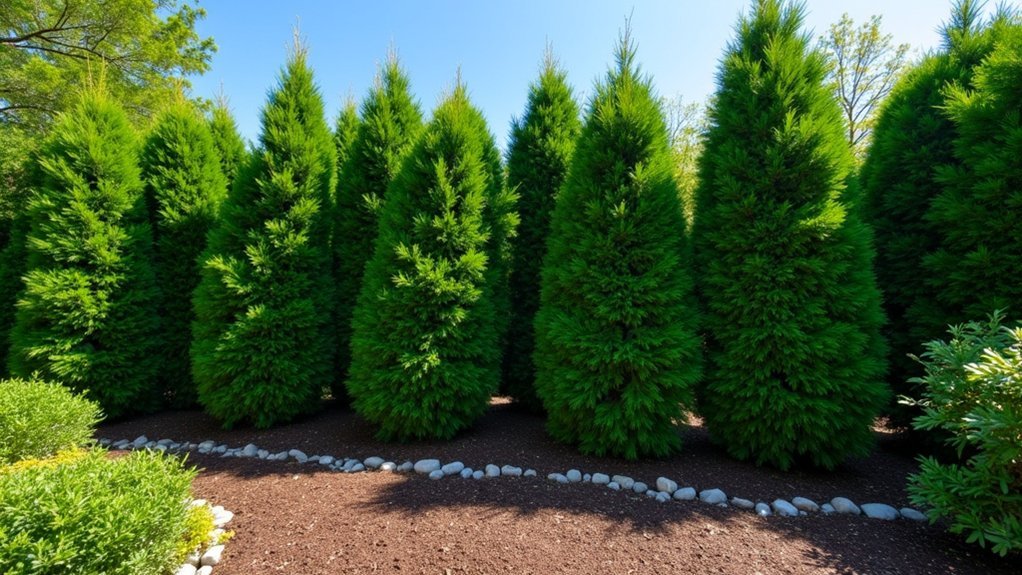
Five outstanding evergreen options can transform your property line into a thriving privacy barrier that works year-round.
Thuja ‘Green Giant’ stands out as a premier choice, reaching impressive heights of 30-40 feet when planted 5-6 feet apart for ideal privacy fence coverage.
For narrower spaces, consider ‘Blue Arrow’ juniper, which grows 16-20 feet tall but only 2-4 feet wide.
The ‘North Pole’ arborvitae offers another excellent option, providing a dense 10-15 foot vertical screen while thriving in zones 3-7.
When planting trees or shrubs for screening, prioritize disease-resistant varieties like certain boxwoods that maintain their formal appearance in zones 4-9.
For a combination of privacy and beauty, dwarf Korean lilac reaches 5 feet tall while adding vibrant spring blooms to your living border.
Strategic Layering Techniques for Dense Coverage
You’ll create maximum privacy by arranging your plants in tall-medium-low formations, placing evergreens like arborvitae at the back, flowering shrubs in the middle, and groundcovers in front.
Establish an evergreen backbone throughout your living fence to maintain coverage during winter months when deciduous plants lose their foliage.
To achieve perfect density balance year-round, mix plants with different bloom times and growth habits, regularly pruning to encourage thicker growth and prevent any seasonal gaps in your privacy screen.
Tall-Medium-Low Plant Arrangement
Successful living privacy fences rely on thoughtful plant arrangement that mimics natural forest edges. Position tall plants like arborvitae or holly at the back, creating your primary 10-15 foot privacy barrier. These evergreen trees provide year-round screening while establishing the foundation of your living fence.
Add medium-height shrubs such as lilacs or boxwoods in the middle layer, creating depth and additional privacy while contributing seasonal visual interest.
In the foreground, incorporate low-growing plants like creeping thyme or dwarf hydrangeas to complete your multi-dimensional barrier.
For maximum effectiveness, space plants an arm’s length apart, allowing room for growth while ensuring dense coverage.
Combine evergreen and deciduous varieties throughout all layers—this strategic mix maintains privacy during winter months while introducing changing colors and textures throughout the seasons.
Evergreen Backbone Strategy
Creating a resilient privacy fence begins with a strategic evergreen backbone that provides year-round screening and structural integrity.
Position taller evergreens (6-8 feet) like Thuja ‘Green Giant’ along your back fence line, as they’ll grow several feet annually with proper care. These fast-growing varieties quickly establish the foundation of your living barrier.
Layer your design by incorporating medium-height evergreen plants (3-5 feet) in the middle section and low-growing varieties (1-3 feet) in front. Native options like Ilex opaca and Juniperus virginiana require less maintenance while supporting local wildlife.
Implement regular pruning techniques to encourage dense growth patterns—this maintains your desired shape while enhancing privacy.
The three-tiered approach creates visual depth, maximizes screening capacity, and guarantees your fence remains effective regardless of season.
Seasonal Density Balance
While evergreens form the backbone of your privacy fence, achieving ideal year-round screening requires thoughtful layering of diverse plant types.
Create depth by positioning tall evergreens at the back, medium shrubs in the middle, and low-growing ground covers in front. This strategic arrangement of different heights not only looks aesthetically pleasing but creates a denser barrier.
For consistent year-round coverage, combine deciduous plants offering spring and summer beauty with steadfast evergreens that provide winter privacy.
Incorporate fast-growing species for immediate impact alongside slower-growing varieties that will eventually fill gaps. Native plants enhance this living fence’s effectiveness while requiring less maintenance.
Don’t neglect regular pruning—it’s essential for maintaining your desired shape and encouraging denser growth throughout all seasons.
Your layering plants will respond with fuller coverage when properly maintained.
Native Plant Combinations for Wildlife-Friendly Boundaries
Creating layered pollinator habitats with native flowering plants like Monarda fistulosa and Spiraea alba will transform your fence into a buzzing ecosystem that supports local wildlife.
You’ll enhance biodiversity by incorporating berry-producing border plants such as Ilex opaca and Viburnum dentatum, which provide essential food sources throughout changing seasons.
Design your boundary with year-round shelter in mind by mixing evergreens like Juniperus virginiana with deciduous shrubs like Cornus sericea to offer wildlife continuous protection while displaying stunning seasonal variations.
Layered Pollinator Habitats
As your privacy fence garden transforms into a thriving ecosystem, layering native plants becomes essential for attracting diverse pollinators to your boundary lines.
Create structure by positioning tall varieties like sunflowers and Joe-Pye weed at the back while planting low-growing groundcovers such as creeping thyme in front.
Incorporate Echinacea purpurea and Asclepias tuberosa into your living fence to provide nectar sources throughout the growing season.
These beautiful natives don’t just add visual interest—they’re vital refueling stations for bees and butterflies.
For a complete wildlife-friendly habitat, integrate shrubs like American holly and arrowwood viburnum.
They’ll offer protective cover and berries for birds while enhancing your layered habitats.
This strategic combination of flowering plants, grasses, and shrubs creates a sustainable boundary that supports local ecosystems while maintaining your privacy.
Berry-Producing Border Plants
Beyond pollinator-friendly plantings, your living fence can transform into a natural food source with strategic berry selections. Incorporating native berry-producing plants creates a wildlife-friendly boundary that offers both privacy and ecological benefits.
| Plant Species | Benefits |
|---|---|
| Vaccinium (Blueberries) | Summer fruit, fall foliage, bird attraction |
| Rubus (Blackberries) | Dense coverage, summer berries, natural barrier |
| Ilex opaca (American holly) | Year-round interest, winter berries, evergreen privacy |
| Amelanchier (Serviceberry) | Spring flowers, summer fruit, fall color |
| Ribes (Currants) | Early fruiting, shade tolerance, beneficial insect habitat |
Regular pruning maintains your privacy fence’s structure while encouraging vigorous fruit production. These berry-producing plants create seasonal displays with spring blooms and summer fruits, ensuring your boundary remains visually engaging throughout the year while supporting local wildlife populations.
Year-Round Shelter Design
While seasonal changes transform gardens throughout the year, a thoughtfully designed living fence can provide consistent wildlife sanctuary regardless of the calendar date.
Combine evergreens like American holly and Eastern red cedar with flowering natives to create a multi-layered habitat that offers privacy and protection in all seasons.
Your living fence will thrive when you incorporate plants like common snowberry and red osier dogwood, which provide critical food sources through berries while maintaining dense cover.
This mixed native plant approach attracts diverse wildlife—from pollinators to birds—while serving as an effective windbreak.
Maintain your year-round shelter with light pruning and regular mulching.
This minimal care guarantees your native plants continue supporting local fauna while forming a beautiful, functional boundary that changes with the seasons yet always provides refuge.
Incorporating Flowering Vines to Soften Structural Elements
The stark lines of a privacy fence can transform into a vibrant, living tapestry when you incorporate flowering vines into your garden design.
These natural climbers add vertical interest while softening hard edges with their lush greenery and seasonal color. You’ll create not just privacy but a thriving ecosystem as flowering vines attract essential pollinators to your garden space.
- Choose clematis, honeysuckle, or wisteria varieties that match your specific climate zone
- Train vines to climb along your privacy fence’s structural elements for maximum coverage
- Consider the sunlight conditions in your garden when selecting appropriate vine species
- Implement regular pruning to control growth and encourage healthier blooms
- Watch as your fence becomes a biodiversity hotspot, supporting bees and butterflies throughout the growing season
Espalier Methods for Space-Efficient Vertical Gardens
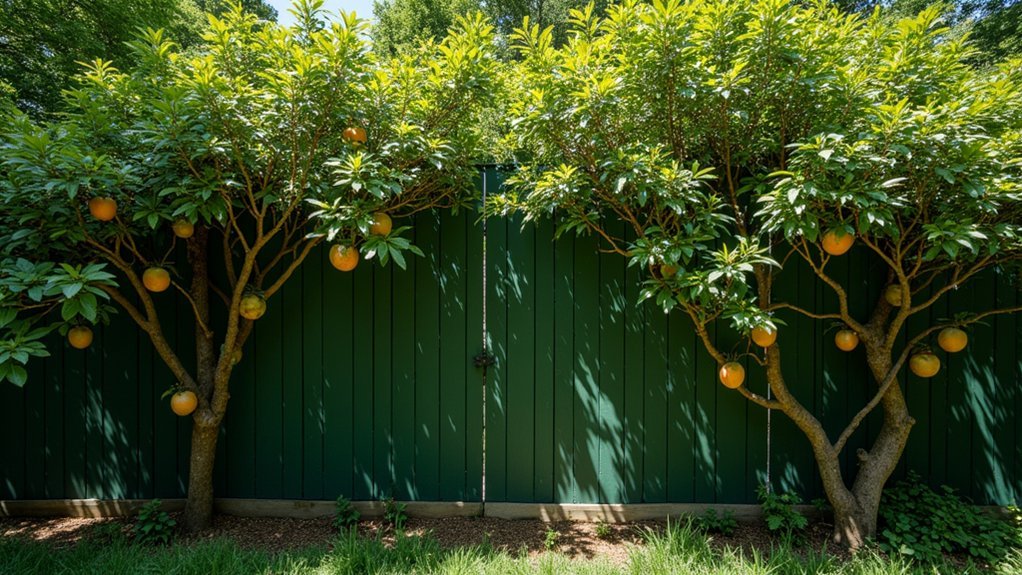
For gardeners with limited space, espalier techniques transform ordinary fences into extraordinary vertical growing systems that maximize every inch of your garden boundary.
This ancient pruning method trains trees and shrubs to grow flat against your existing privacy fence, creating living artwork that serves multiple purposes.
You’ll find that espaliered plants not only enhance privacy but also improve air circulation and sunlight exposure, leading to healthier growth and better fruit production.
Choose apple or pear trees for edible harvests, or select ornamental shrubs for year-round visual interest.
Commit to regular pruning sessions twice yearly to maintain your vertical garden’s form.
Seasonal pruning creates the framework for success, transforming random growth into deliberate botanical architecture.
With patience and consistent attention, you’ll develop a space-efficient living fence that provides seclusion while adding sophisticated structure to your outdoor sanctuary.
Maintaining Healthy Growth Through Proper Pruning Schedules
Maintaining your carefully trained espalier or living fence requires a thoughtful pruning regimen that follows the natural rhythms of plant growth. Schedule 1-2 pruning sessions annually to maintain shape and encourage healthy growth, especially during the establish phase of your privacy barrier.
- Time your major pruning for late winter to early spring before new growth emerges.
- Use only sharp, clean tools to make precise cuts that heal quickly and prevent disease spread.
- For informal native hedges, apply lighter pruning techniques while still promoting density.
- Avoid heavy trimming late in the growing season to reduce plant stress.
- Combine your pruning schedule with consistent watering and mulching to support root development during the vital first 2-5 years.
Creative Trellising Solutions for Climbing Plant Integration

While your living privacy fence creates a solid foundation for boundary definition, integrating creative trellising can dramatically enhance both function and visual appeal. By thoughtfully positioning trellises along your fence line, you’ll create visual depth that transforms a simple barrier into a lush garden feature.
| Trellis Material | Best For | Maintenance | Design Impact |
|---|---|---|---|
| Wood | Clematis | Annual sealing | Rustic charm |
| Metal | Honeysuckle | Minimal pruning | Modern elegance |
| Bamboo | Jasmine | Replacement every 3-5 years | Natural aesthetic |
| Copper | Climbing roses | Regular pruning | Artistic patina |
Remember to train your climbing plants regularly as they grow, guiding stems through the trellis structure. This strategic approach to creative trellising solutions guarantees your privacy fence becomes a dynamic, multi-dimensional landscape element rather than just a boundary marker.
Frequently Asked Questions
What Plants Are Good for Living Fences?
You’ll find conifers like Thuja ‘Green Giant’ and Juniper ‘Blue Arrow’ excel as living fences. Consider boxwood for formal hedges, flowering lilacs for seasonal beauty, evergreen hollies for year-round privacy, and native junipers for sustainability.
How to Make a Privacy Fence Look Nicer?
You can beautify your privacy fence by adding climbing plants, using decorative planters, painting it a complementary color, hanging outdoor art, and creating layered plantings of varying heights against the backdrop.
What Are the Disadvantages of a Life Fence?
You’ll face several challenges with living fences: they take years to establish, require regular pruning, attract pests, suffer during extreme weather, and might clash with HOA regulations. They’re beautiful but demand patience and maintenance.
How Long Does a Living Fence Take to Grow?
Your living fence will take 2-5 years to fully establish. You’ll see faster results with species like Thuja ‘Green Giant,’ especially if you’re providing ideal soil conditions and regular maintenance during establishment.
In Summary
You’ve now got all the tools to transform your property line into a thriving, living privacy solution. By combining fast-growing evergreens, strategic layering, and wildlife-friendly natives with flowering vines and espalier techniques, you’ll create a boundary that’s both functional and beautiful. Don’t forget that regular pruning and creative trellising will keep your privacy fence garden looking its best year after year.

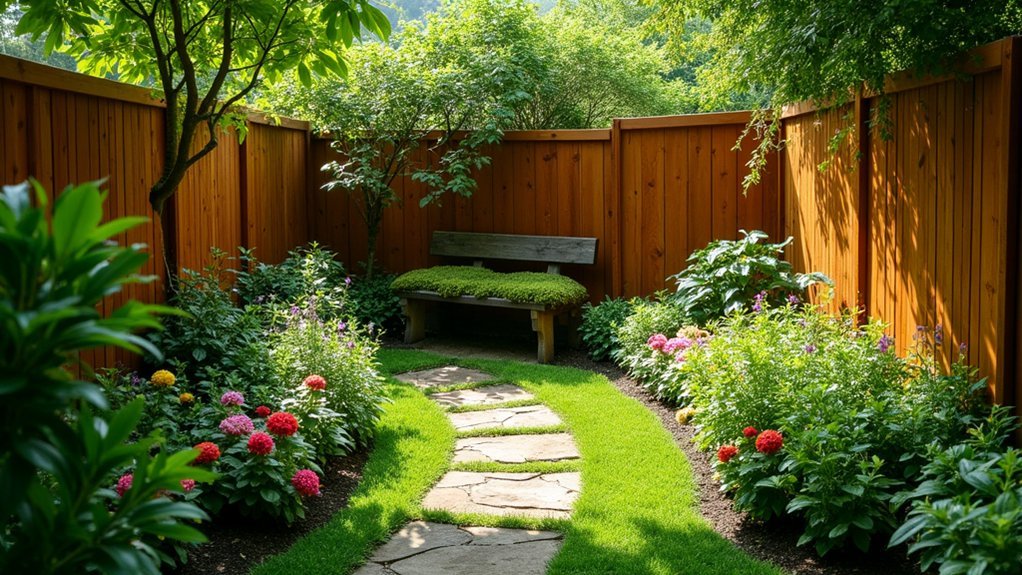

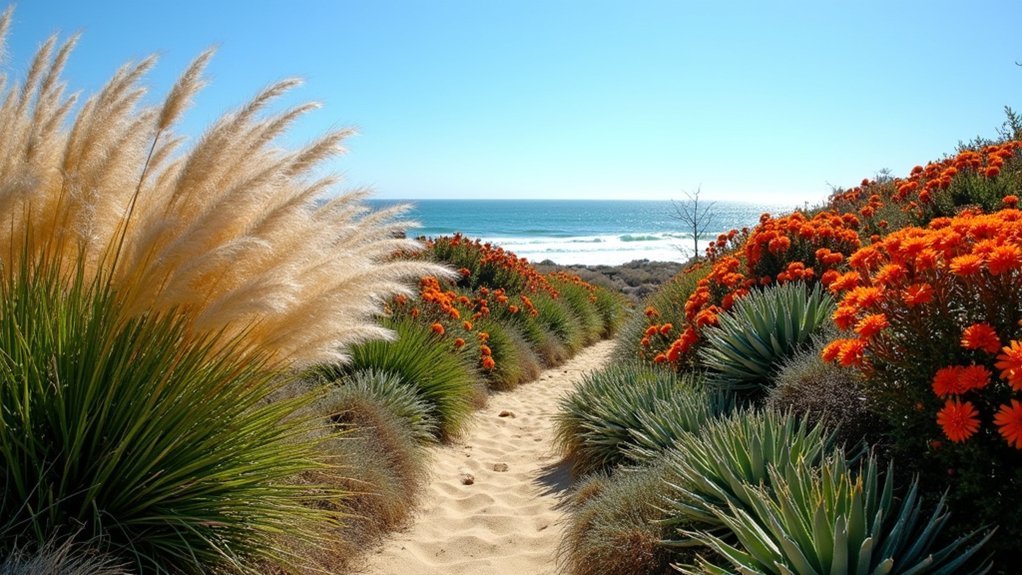
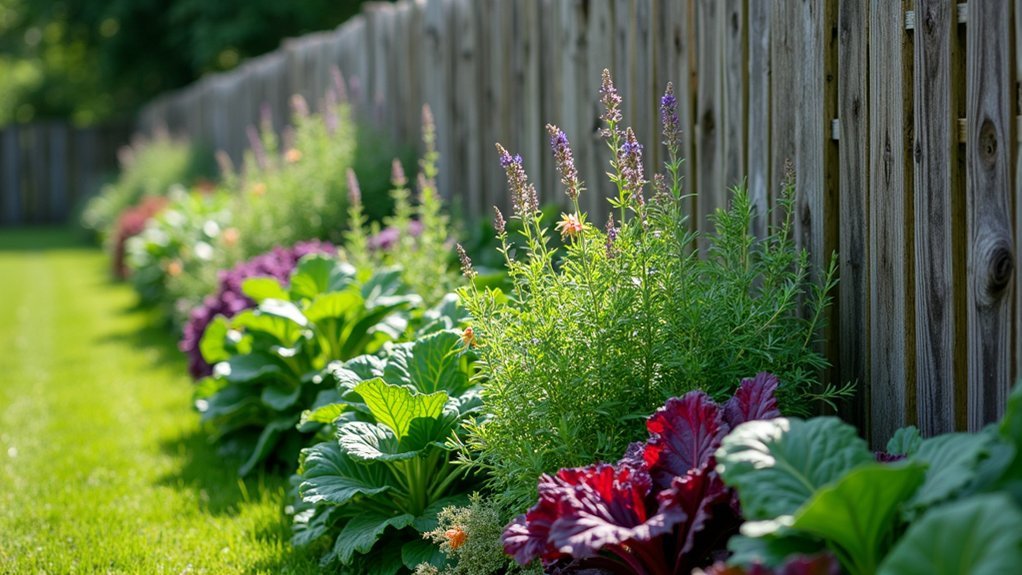
Leave a Reply